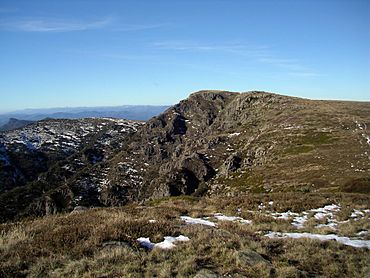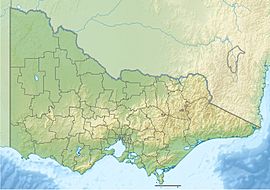Alpine National Park facts for kids
Quick facts for kids Alpine National ParkVictoria |
|
|---|---|
|
IUCN Category II (National Park)
|
|

The summit of Mount Howitt taken from West Peak
|
|
| Nearest town or city | Omeo |
| Established | 1989 |
| Area | 6,474 km2 (2,499.6 sq mi) |
| Managing authorities | Parks Victoria |
| Website | Alpine National Park |
| See also | Protected areas of Victoria |
The Alpine National Park is a huge national park located in the Central Highlands and Alpine areas of Victoria, Australia. This park covers about 646,000 hectares (that's over 1.5 million acres!). It's found northeast of Melbourne.
It's the biggest National Park in Victoria. It includes many of the highest parts of the Great Dividing Range in Victoria. This includes Victoria's tallest point, Mount Bogong, which is 1,986 meters (6,516 feet) high. The park also has special subalpine woodlands and grasslands, like those on the Bogong High Plains. The park's northern border is right next to New South Wales, where it meets the Kosciuszko National Park. In 2008, the Alpine National Park was added to the Australian National Heritage List. It's part of a group of eleven special areas called the Australian Alps National Parks and Reserves.
Contents
Nature in the Alpine National Park
Different Zones
The park has different natural zones based on how high up they are:
- Alpine Zone: This is the highest part, usually above 1,800 meters (5,900 feet). Here, it's too cold for tall trees to grow. You'll find small shrubs, tough grasses, and plants that grow close to the ground.
- Sub-alpine Zone: Below the alpine zone, you'll see open forests mostly filled with snow-gum trees. There are also large areas of grasslands. Some cold, flat areas in this zone have special Sphagnum bogs.
- Montane Zone: This is the lowest zone. On the wetter, southern side of the alps, it has thick forests and even rainforests. You'll find tall trees like Alpine Ash and Mountain Ash. The ground is covered with shrubs, grasses, and ferns. On the drier, northern side, there are dry forests with different kinds of eucalypt trees.
Amazing Bogs
The bogs in the sub-alpine zone are super important. They collect water from snowmelt and rain. A key plant in these bogs is Sphagnum Moss. It's like a giant sponge, soaking up to 20 times its own weight in water! These bogs then slowly release the water during summer. This keeps the creeks and streams flowing all year round.
Protecting the Bogs
It's really important to protect these Sphagnum bogs. If animals (like wild pigs, cattle, horses, or even too many people) walk on them, they can get damaged. When damaged, they can't hold water as well. This means water rushes out quickly in spring, causing erosion (when soil washes away). Then, in summer, the creeks might dry up. Fires can also harm the plants along rivers, leading to more erosion.
Forest Life
The forests in the park are home to many different birds and mammals. Some animals need specific types of plants to find food. Others need older trees with big hollows to live in. Rainforests grow without needing fire, and some of their plants can't handle fire. But many eucalypt trees actually need fire to help their seeds grow.
Dry Forests and Challenges
The dry forests often border private land. This means they've sometimes been cleared or changed. The main challenges here are managing fires (to protect homes), stopping weeds from spreading, and making sure different patches of forest are connected so animals can move around safely.
Animals of the Park
The Alpine National Park helps protect many animals that are in danger. These include:
- The spotted tree frog
- The she-oak skink
- The smoky mouse
- The broad-toothed mouse
- The mountain pygmy possum
The special Alpine Bogs and Fens (wetlands) are now officially listed as a threatened natural community by the Australian government.
Bushfires in the Park
The park has had some big bushfires. Lightning strikes started huge fires in January 2003 and again in December 2006. Each of these fires burned over 10,000 square kilometers (about 3,860 square miles) for many weeks. The famous Black Friday fires in 1939 were also very large.
While fire is a natural part of many Australian environments, some alpine areas, like the bogs, are very sensitive to it. The 2003 fires left a mix of burned and unburned areas. But in some places where the 2006-07 fires burned over the same ground, plants and animals have had a hard time recovering. In January 2013, another lightning strike started a large bushfire that burned for about two months.
Farming History
For a long time, farmers used to graze cattle in the park during summer. This started around the 1840s. However, people became worried about how this affected the environment. Over the years, different governments decided to stop grazing in parts of the alps.
For example, cattle grazing stopped in Mount Buffalo National Park in 1952. It also stopped in Kosciuszko National Park in New South Wales in the 1950s and 60s. This was because people were concerned about water quality for the Snowy River Scheme. Grazing was also removed from Mounts Feathertop, Hotham, and Bogong around that time. By the early 1990s, about one-third of the Alpine National Park was still open for grazing.
In 2005, the Victorian Government decided to ban cattle grazing in the rest of the Alpine National Park. They still allowed grazing in nearby state forests. When the government announced this, the Federal Government thought about using special heritage powers to keep grazing. This was because of the cultural importance of the "mountain cattleman," especially known from the poem The Man from Snowy River.
Cattle were banned from the park for over five years, which made the farmers upset. In 2011, a small number of cattle were allowed back into fenced areas for a short time. By 2013, the Victorian Government wanted to try a three-year plan to bring grazing back. They said it was to help manage plants and weeds.
Things to Do
The Alpine National Park is a popular place for outdoor activities, especially in summer.
Summer Fun
- Bushwalking: You can go for long walks on many tracks.
- Mountain Biking: Ride your bike on exciting trails.
- Four-wheel Driving: Explore the park in a tough vehicle.
- Fishing: Try to catch some fish in the park's waters.
The main reasons people visit in summer are the cooler mountain weather and the amazing views of Victoria's highest peaks. The Australian Alps Walking Track, a 650-kilometer (400-mile) path from Walhalla to Canberra, goes right through the park. You can also camp in the bush, but you need to follow the park rules.
Winter Adventures
In winter, most of the park is covered in snow. You can only get around on skis. Mount Hotham and Falls Creek are ski resorts next to the park. From there, skiers can go into the park to areas like the Bogong High Plains and Mount Bogong.
Hunting
Hunting is also a popular activity in winter. You can hunt Sambar deer (without dogs) from mid-February to mid-December.
Tallest Mountains
Here are some of the major peaks in the Alpine National Park, from highest to lowest:
| Peak name | Elevation | Prominence | Source(s) | ||
|---|---|---|---|---|---|
| m | ft | m | ft | ||
| Mount Bogong | 1,986 | 6,516 | 1,233 | 4,045 | |
| Mount Feathertop | 1,922 | 6,306 | 562 | 1,844 | |
| Mount Nelse North | 1,882 | 6,175 | |||
| Mount Nelse | 1,876 | 6,155 | |||
| Mount Loch | 1,865 | 6,119 | |||
| Mount Fainter South | 1,861 | 6,106 | |||
| Mount McKay | 1,849 | 6,066 | |||
| Spion Kopje | 1,837 | 6,027 | 77 | 253 | |
| The Jaithmathangs | 1,826 | 5,991 | |||
| Mount Cope | 1,824 | 5,984 | |||
| Mount Fainter North | 1,817 | 5,961 | |||
See also
 In Spanish: Parque nacional Alpino para niños
In Spanish: Parque nacional Alpino para niños


